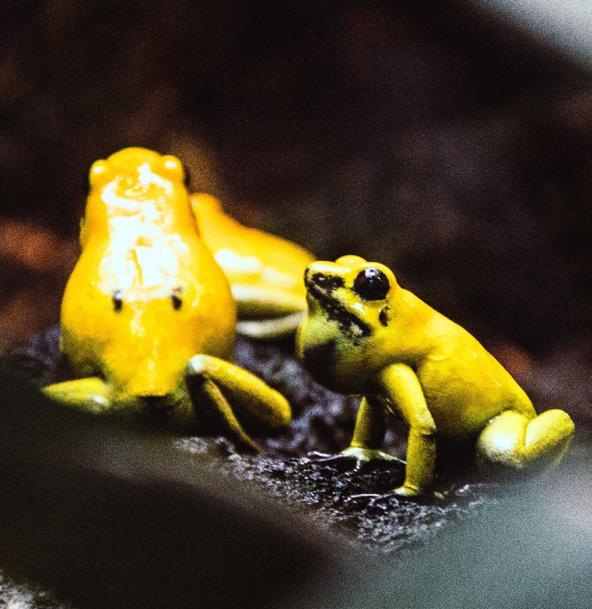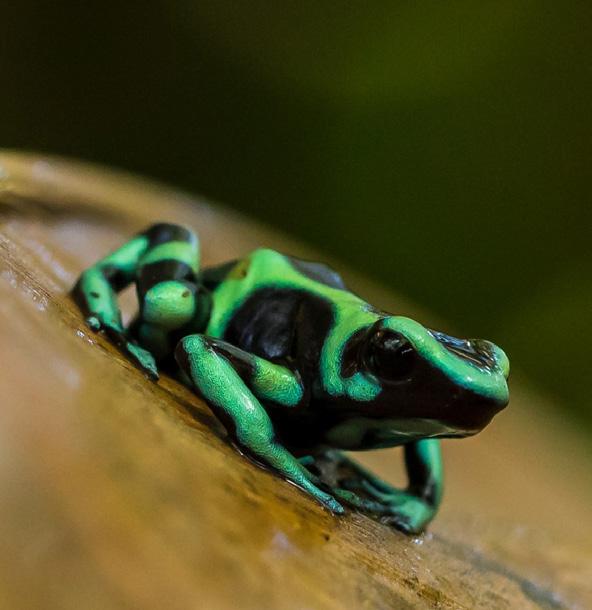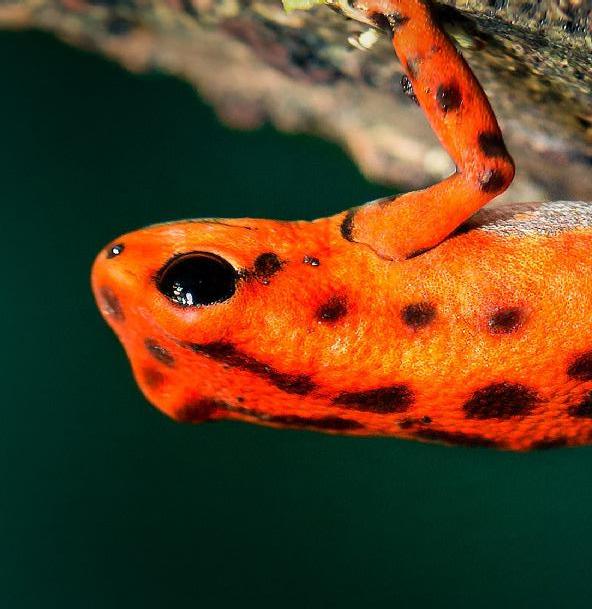
3 minute read
DENDROBATIDAE - POISON DART FROGS
DENDROBATIDAE 20
POISON DART FROGS
Advertisement
The golden poison frog (Phyllobates terribilis), also known as the golden frog, golden poison arrow frog, or golden dart frog, is a poison dart frog endemic to the Pacific coast of Colombia. The optimal habitat of P. terribilis is the rainforest with high rain rates (5 m or more per year), altitudes from sea level to 200 m elevation, temperatures of at least 26 °C, and relative humidity of 80–90%. In the wild, P. terribilis is largely solitary and territorial; however, captive P. terribilis specimens can live in much larger groups. They may appear innocuous but they are the most lethal out of of all the other dendrobatidae. They are the species that produces the Batrachotoxin. P. terribilis is the largest species of poison dart frog, and can reach a size of 55 mm as adults, with females typically being larger than males. Like all poison dart frogs, the adults are brightly colored, but they lack the dark spots present in many other dendrobatids. The green-and-black poison dart frog (Dendrobates auratus), also known as the green-and-black poison arrow frog and green poison frog, is a brightly colored member of the order Anura native to Central America and northwestern parts of South America. This species has also been introduced to Hawaii. It is one of the most variable of all poison dart frogs next to Dendrobates tinctorius and some Oophaga spp. It is considered to be of least concern from a conservation standpoint by the International Union for Conservation of Nature. Males average 0.75 inches (1.9 cm), while females are slightly larger, averaging an inch or longer. The green-and-black poison frog typically has mint-green coloration The green-and-black poison dart frog, while not the most toxic poison dart frog, is still a highly toxic animal. The very small amount of poison the frog possesses is enough to make a human heart stop beating.

The blue poison dart frog or blue poison arrow frog (Dendrobates tinctorius azureus) is a poison dart frog found in the forests surrounded by the Sipaliwini Savanna, which is located in southern Suriname and adjacent far northern Brazil. It is also known by its indigenous Tiryò name, okopipi. D. tinctorius azureus is a medium-sized frog that weighs about 8 g and grows to 3.0-4.5 cm in length. Females are larger and about half a centimeter longer than males, but males have larger toes. The frog has a typical lifespan of five to seven years in the wild. Its bright blue skin, usually darker around its limbs and stomach. Their poisons paralyze and sometimes kill the predator. The black spots are unique to each frog, enabling individuals to be identified. This species of frog has a distinctive hunch-backed posture and males and females can be distinguished by the shape of the tips of the toes, round in females, while heart-shaped in males. The strawberry poison-dart frog (Dendrobates pumilio) is a species of small poison dart frog found in Central America. It is common throughout its range, which extends from eastern central Nicaragua through Costa Rica and northwestern Panama. The species is often found in humid lowlands and premontane forest, but large populations are also found in disturbed areas such as plantations.The strawberry poison frog is perhaps most famous for its widespread variation in coloration, comprising approximately 15–30 color morphs. D. pumilio, while not the most poisonous of the dendrobatids, is the most toxic member of its genus. Pumiliotoxin 251D is the specialized toxin that is secreted by this species. This toxin has a negative stimulating effect on cardiac function and is a severe disruptor of the sodium potassium channels within cells. Upon ingestion organisms preying on D. pumilio experience convulsions, paralysis, and death.










